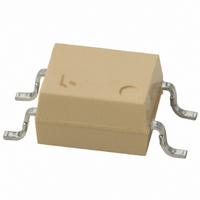TLP181(GB) Toshiba, TLP181(GB) Datasheet

TLP181(GB)
Specifications of TLP181(GB)
Related parts for TLP181(GB)
TLP181(GB) Summary of contents
Page 1
... TOSHIBA Photocoupler GaAs Ired & Photo−Transistor Office Machine Programmable Controllers AC / DC−Input Module Telecommunication The TOSHIBA mini flat coupler TLP181 is a small outline coupler, suitable for surface mount assembly. TLP181 consist of a photo transistor optically coupled to a gallium arsenide infrared emitting diode. · ...
Page 2
Current Transfer Ratio Classification Type *1 (None) Rank Y TLP181 Rank GR Rank BL Rank GB *1: EX, Rank GB: TLP181 (GB) (Note) Application, type name for certification test, please use standard product type name TLP181 (GB): TLP181 ...
Page 3
Maximum Ratings (Ta = 25°C) Characteristic Forward current Forward current detating Pulse forward current (100µs pulse, 100pps) Reverse voltage Junction temperature Collector-emitter voltage Emitter-collector valtage Collector current Collector power dissipation (1 Circuit) Collector power dissipation derating (1 Circuit Ta ≥ ...
Page 4
Individual Electrical Characteristics Characteristic Forward voltage Reverse current Capacitance Collector-emitter breakdown voltage Emitter-collector breakdown voltage Collector dark current Capacitance (collector to emitter) Coupled Electrical Characteristics Characteristic Current transfer ratio Saturated CTR Collector-emitter saturation voltage Off-state collector current Isolation Characteristics Characteristic ...
Page 5
Swiching Characteristics Characteristic Rise time Fall time Turn-on time Turn-off time Turn-on time Storage time Turn-off time Fig. 1 Switching time test circuit I F (Ta = 25°C) Symbol Test Condition ...
Page 6
I – 100 - Ambient temperature Ta (°C) I – 3000 Pulse width ≤ 100µ 25°C 1000 500 300 100 ...
Page 7
I – 25°C 50mA 40 30mA 20mA 15mA 30 10mA P C (MAX 5mA Collector-emitter voltage – ...
Page 8
V – Ta CE(sat) 0. 1mA 0.2mA 0.20 0.16 0.12 0.08 0.04 0 -40 - Ambient temperature Ta (°C) Switching Time – 1000 Ta = 25° ...
Page 9
... TOSHIBA is continually working to improve the quality and reliability of its products. Nevertheless, semiconductor devices in general can malfunction or fail due to their inherent electrical sensitivity and vulnerability to physical stress the responsibility of the buyer, when utilizing TOSHIBA products, to comply with the standards of safety in making a safe design for the entire system, and to avoid situations in which a malfunction or failure of such TOSHIBA products could cause loss of human life, bodily injury or damage to property ...










